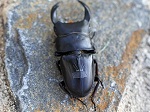
Using Insects to Advance Cybernetics

Credit: UNIST/American Chemical Society
While a majority of the attention on cybernetic technology has been paid to human test subjects, more researchers are now looking into what the interface between animals and machinery might soon look like. Graphene and carbon nanotubes have been melded together into a single mesh that works on a monolithic architecture. This flexible electronic device can then actually interface with living things. ---South Korean researchers have been able to synthesize these circuits in a single step [Citation below]. They’ve used multiple catalysts to synthesize electronic devices out of carbon. Much like integrated circuit chips, these patches can include electrodes, connectors, sensory devices and transistors in a single unit. While they might appear physically wider than semiconductor units, they are infinitesimally thin.--Naturally carbon nanotubes exhibit semiconducting properties, which make them particularly attractive for this kind of research. Graphene is a pure conductor, so it serves as an interconnecting material. Most interestingly, the device has been installed on the back of live stag beetles. They can be set loose in different environments and from there they can start to detect things like nerve gas agents[F42].
Credit: UNIST/American Chemical Society
Cyborg beetles can also detect a wide variety of environmental issues, and since the insects are generally considered more expendable than human test subjects, they could be used in areas where it wouldn’t be appropriate or safe to send human technicians. That being said, other tests have been successful in merging the equipment with other types of organisms. For example, plant fronds can have the chips implanted in them. As shown in the photo, it doesn’t appear that the organic tissue is at all rejecting the installation[F43].
Integrated antennas are used to deliver power directly to these types of devices, which makes them function entirely without batteries. Including batteries on organic material can prove very difficult to work with. The flexible surface remains attached to organic substances because of the attractive forces between molecules that haven’t formed covalent bonds. These same antennas can be used to relay information from cybernetic beetles, so there’s no need for any additional sensing equipment[F44].
Eventually, pint-sized beetle cyborgs will be useful for detecting pollution and radiation. Roaches and other insects could easily have the same implants installed, and these systems could be used for a variety of sensory uses. It even opens up a number of defense possibilities with regards to cybernetics. While many people are interested in advances in human cybernetics (myself included), it seems highly likely that the future will involve interfacing computer technology with the insectoid species as well.
My take on this ~ “they are showing you super soldier elements of human and nano tech integrating a human with an ant or wasp or other insects to control there gestalt thinking and to utilize these bugs to carry out for use of battles”
Tony
Reference:
Lee K, Park J, Lee MS, Kim J, Hyun BG, Kang DJ, Na K, Lee CY, Bien F, & Park JU (2014). In-situ Synthesis of Carbon Nanotube-Graphite Electronic Devices and Their Integrations onto Surfaces of Live Plants and Insects. Nano letters DOI: 10.1021/nl500513n.